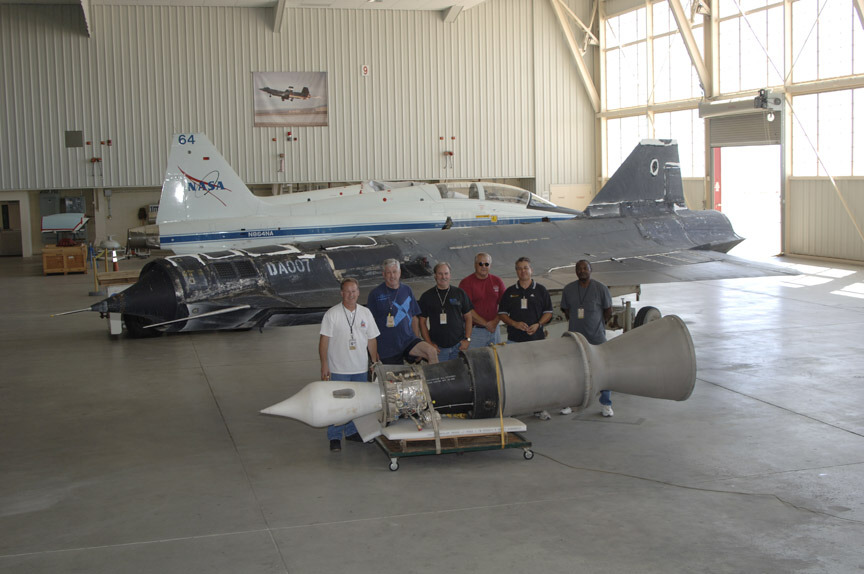


 |
 |
 |
As a favor to the USAF Museum, NASA offered to pull an engine from D-21 Article #537 for delivery to a civilian museum. By USAF Museum standards the engine had to be removed because of material containing a trace of radioactivity for which civilian museums are not licensed. Roadrunner and NASA Dryden artist/photographer and author Tony Landis volunteered to photograph the removal for the benefit of those who have never actually seen a ramjet engine before. With some great information provided by Roadrunner Jerry Miller, the NASA mechanics had no trouble pulling the engine.
This was the first of three such engine removals being conducted by NASA as it transfers to museums the D-21s previously stored on the lake bed. NASA acquired 4 D-21's back in 1993. NASA loaned one to the AFFTC museum which is on display at the Blackbird Airpark. The other three were stored on the lakebed near NASA. Ownership of the drones was recently turned back over to the USAF Museum which has been allocating them to various museums. Since most of these are civilian museums, the engine has to be removed due to radiation. NASA offered to do this for them and then they could easily truck the engines back to Wright-Patterson for disposal and each museum could come and get their drone.
 In the D-21 group shot are L-R: Jeff Doughty, Mike Relja, Randy Button, Roger Lynn, Enrique 'Henry' Hernandez & Don Warren
In the D-21 group shot are L-R: Jeff Doughty, Mike Relja, Randy Button, Roger Lynn, Enrique 'Henry' Hernandez & Don Warren
Photos and more about the M-21/D-21 and D-21 Tagboard projects can be viewed on Leland Haynes' SR-71 Blackbird web site, TD Barnes' Area 51 Special Projects web site, and this Roadrunners Internationale web site at the links below.
|
NASA Dryden artist/photographer and author Tony Landis was born and raised in Southern California and joined the Air Force right out of high school. He has had a life-long interest in aerospace history and images from his photo collection have been published in hundreds of publications. He has been listed as a contributing photographer, editor and artist in "Wings/Airpower" magazine and has worked at NASA Dyden Flight Research Center for the last nine years. Landis has written "The Lockheed NF-104A Starfighter" (Ginter Books, 1999), the "Lockheed AH-56A Cheyenne" (Specialty Press, 2000), and "The North American XB-70A Valkyrie" (Specialty Press, 2002). His most recent book was one he co-authored with Yancy D. Mailes titled: "F-117 Nighhawk Stealth Fighter Photo Scrapbook." Tony was instrumental in obtaining recognition of three X-15 pilots of the 1960's as astronauts and as an associate member of Roadrunners Internationale, has been a major asset to the association's mission of preserving the Cold War history and legacy of the Roadrunners of Area-51 and Kadena of that same era.
Jerry has intimate knowledge of the D-21 and has been a great help in correcting a common misidentification of D-21 Ramjet Engine model numbers. Somewhere through the passage of time, the D-21 engine became identified as a Marquardt XRJ 43-MA20, the same engine as used on the Bomarc B Interceptor Missile. According to Jerry, the D-21 engine is properly identified as an XRJ 43-MA20S-4.
According to Jerry, the XRJ 43-MA20 was a complete, externally mounted, ramjet engine with a fixed geometry, Mach 2.35, isentropic spike inlet. The engines' integral combustion chamber/exit nozzle was designed for relatively low altitude cruise and therefore did not have a high expansion ratio nozzle. The ignition system was two pyrotechnic flares. There was no re-ignition capability. The fuel control and flame holder combustion limits would not allow operation at high altitudes. The MA20 engine, used on the Bomarc, contained an all pneumatic fuel control that maintained constant Mach Number at two selectable Mach Numbers using pressure signals from the "built in" inlet. This engine could function as an independent external power plant on any vehicle that could reach sufficient speed to cause efficient inlet operation. It was developed in supersonic wind tunnels at Marquardt's Van Nuys, California test facility, flight tested on the Lockheed X-7A3 at Holloman AFB, Alamogordo, NM and deployed operationally on the Bomarc B
The MA20S-4 engine, used in the D-21, used many of the MA20 components, but modified to operate at lower pressures and higher temperatures. The S-4 was immersed in the body of the D-21 and had no inlet structure (because it used the D-21 inlet system). The engine centerbody and main structure remained, to house the fuel control, fuel pump, fuel injector nozzles and flameholder assembly. The flame holder system was redesigned to allow for stable combustion at extremely high altitude, high temperature and low pressure. Ignition was by TEB (TriEthylBoran) to allow for re-ignition in the event of flameout. The combustion chamber/exit nozzle was redesigned to provide for the much greater expansion ratio required for high altitude cruse. The design also incorporated an ejector system to provide for engine structure cooling.
The pneumatic fuel control computer was modified to function at much lower pressures and higher temperatures. The input pressure signals were modified to accept air data from the D-21 inlet and to maximize full power operation limited only by the D-21 inlet conditions and mission parameters. The fuel flow schedule, pumps, controls and injector nozzles were redesigned to permit accurate flow control and injection at the much lower air flow requirements of extreme high altitude.
If it would be possible to display both of these engines on a dolly, side by side, they would not look at all alike. They have common roots (in the Marquardt 43" diameter ramjet family) but the similarity ends there. So far, attempts to display these engines have been stopped by the environmental concerns of some authorities. Much of the centerbody construction is a Magnesium Thorium alloy, which explains why the engine had to be removed prior to shipment to a civilian museum.
 |
 |
 |